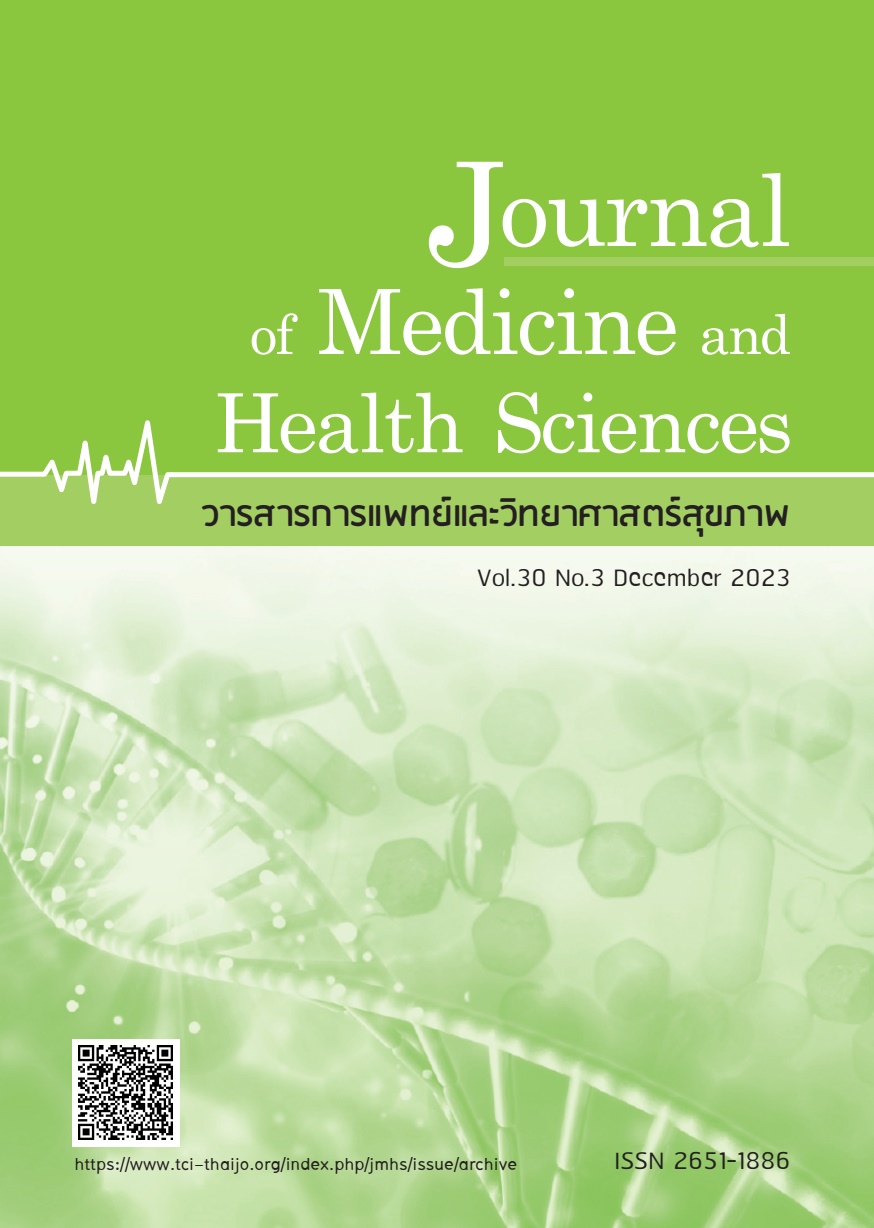Cancer risk assessment of personnel occupationally exposed to formaldehyde in a medical school
Keywords:
formaldehyde, carcinogen, cancer risk assessment, medical staffsAbstract
Formaldehyde, a well-known human carcinogen in IARC Group 1, is used in various industries, with hospitals being one of the places that widely utilize it. Several medical staff
members were exposed to a high concentration of formaldehyde. Therefore, this study aims to evaluate concentrations of formaldehyde exposure and cancer risk in medical staff. In this study, data were collected using the NIOSH 2016 method, applying personal sampling to medical staff during working hours for each job task. Then, this data was utilized to calculate cancer risk. Based on a sample size of 77 samples, the average formaldehyde concentration from the personal sampler was 0.0286 ppm, with the highest formaldehyde exposure being 0.0518 ppm during the teaching of gross anatomy and the lowest exposure being 0.0066 ppm in microscopic parasitology. The formaldehyde concentration was classified into high and low-exposure groups, where the high-exposure group included formaldehyde concentrations above 0.016 ppm. This group encompassed tasks such as teaching gross anatomy, embalming, injecting formaldehyde into cadavers, autopsy, and preparing gross anatomy class. The estimated lifetime cancer risk, as per US EPA guidelines, found that almost all medical staff had a potential cancer risk, except in microscopic and preparing parasitology, where the risk was deemed acceptable. In conclusion, medical staff exposed to formaldehyde should receive proper protection from exposure and undergo medical surveillance through annual physical examinations according to the risk.
References
Formaldehyde, solution, flammable: CAS Number 50-00-0 [Internet]. n.d. [cited 2020 Nov 29]. Available from: https://kku.world/o1mcc.
Occupational Safety and Health Administration. Laboratory safety biosafety cabinets (BSCs) [Internet]. n.d. [cited 2020 Nov 28]. Available from: https://kku.world/d3sck.
Occupational Safety and Health Administration. 1910.1048 App A: substance technical guidelines for formalin [Internet]. 2013 [cited 2020 Nov 28]. Available from: https://kku.world/r9puu.
National Institute for Occupational Safety and Health. NIOSH pocket guide to chemical hazards. Cincinnati (OH): NIOSH;2007.
Ochs S de M, Grotz L de O, Factorine LS, et al. Occupational exposure to formaldehyde in an institute of morphology in Brazil: a comparison of area and personal sampling. Environ Sci Pollut Res Int 2011;19:2813-9.
Bosetti C, McLaughlin JK, Tarone RE, et al. Formaldehyde and cancer risk: a quantitative review of cohort studies through 2006. Ann Oncol 2008;19:29-43.
Division of Occupational and Environmental Diseases. Medical surveillance in workplaces that use formaldehyde for medical. Nonthaburi: The Division; 2018. [in Thai]
Promtes K, Kaewboonchoo O, Harncharoen K, et al. Cancer risk assessment of inhalation formaldehyde exposure among medical students during anatomy laboratory. Thai J Toxicol 2014;29:8-22. [in Thai]
Boonyayothin V, Phanprasit W, Tantipanjaporn T. Cancer risk assessment of formaldehyde exposure via inhalation among autopsy staffs. Roy Thai Army Med J 2018;17:36-49. [in Thai]
Yahyaei E, Majlesi B, Naimi Joubani M, et al. Occupational exposure and risk assessment of formaldehyde in the pathology departments of hospitals. Asian Pac J Cancer Prev 2020;21:1303-9.
Pahasup-anan T, Chesuemae S, Samae S, et al. Risk assessment of formaldehyde in gross anatomy laboratory in a university. J Energy Environ Technol 2563;7:61-8. [in Thai]
Kangarlou MB, Fatemi F, Dehdashti A, et al. Occupational health risk assessment of airborne formaldehyde in medical laboratories. Environ Sci Pollut Res Int 2023;30:50392-401.
National Institute for Occupational Safety and Health. NIOSH manual of analytical methods 2016: formaldehyde [Internet]. 2003 [cited 2021 Apr 13]. Available from: https://kku.world/h6nqz.
United States. Environmental Protection Agency. Office of Superfund Remediation and Technology Innovation. Risk assessment guidance for Superfund: interim. Vol. I: human health evaluation manual (Part F, Supplemental guidance for inhalation risk assessment). Washington, DC: US EPA; 2009.
Prasartkul P, Chuanwan S. From 50 million population to an elite elderly society [Internet]. 2022 [cited 2022 Dec 18]. Available from: https://kku.world/y245s. [in Thai]
Hirst DVL, Gressel MG, Flanders WD. Short-term monitoring of formaldehyde: comparison of two direct-reading instruments to a laboratory-based method. J Occup Environ Hyg 2011;8:357-63.
World Health Organization. Formaldehyde. In: Air quality guidelines for Europe. 2nd ed. Copenhagen: World Health Organization, Regional Office for Europe; 2000. p. 87-91.
Aung WY, Sakamoto H, Sato A, et al. Indoor formaldehyde concentration, personal formaldehyde exposure and clinical symptoms during anatomy dissection sessions, university of medicine 1, Yangon. Int J Environ Res Public Health 2021;18:712.
Downloads
Published
How to Cite
Issue
Section
License

This work is licensed under a Creative Commons Attribution-NonCommercial-NoDerivatives 4.0 International License.



